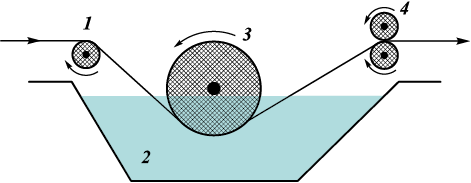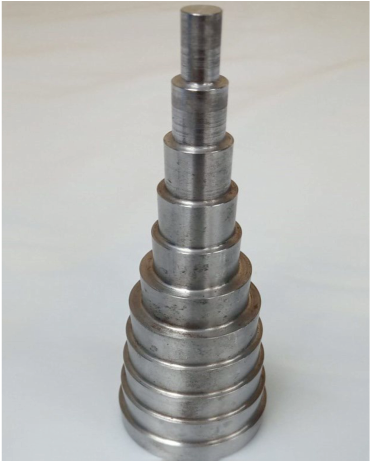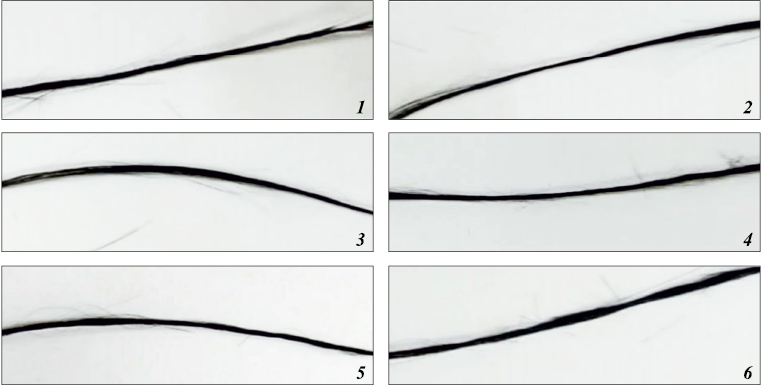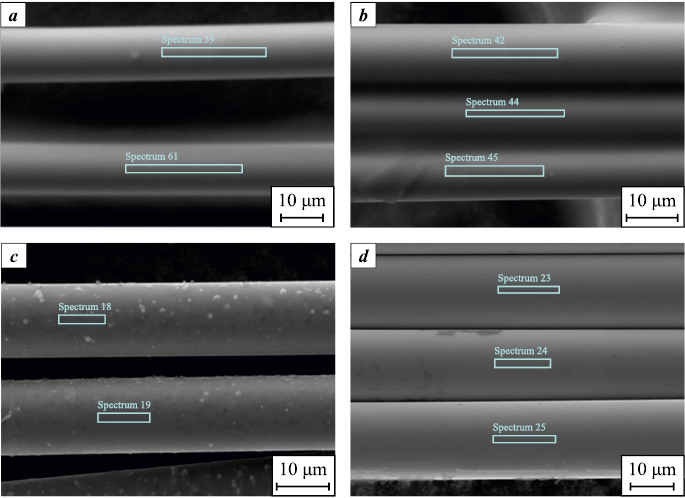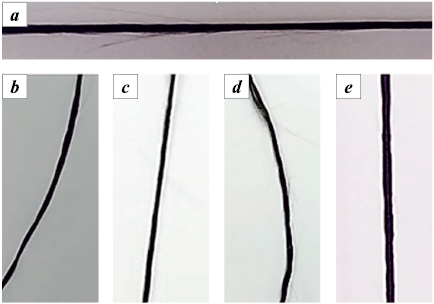Scroll to:
The effect of an oiling agent on the technological properties of coreless silicon carbide fiber
https://doi.org/10.17073/1997-308X-2024-5-30-36
Abstract
A study was conducted to investigate the influence of oiling agents with various formulations on the properties of coreless silicon carbide fiber from the perspective of its technological qualities. The oiling agents investigated included formulations of PMS-5, PMS-10, PMS-20 in isopropyl alcohol and acetone, aqueous emulsions of PMS-200 with the addition of dispersant IVP-317 and polyvinyl alcohol, an aqueous solution of PEG-400 (30 %), and an aqueous solution of starch (10 %). The evaluation of the oiling agent’s impact on the technological properties of the fiber was carried out through tensile strength testing, determination of the minimum bending radius, examination of the surface morphology of the oiled fibers, and the ability of the tested composition to bundle filaments together and reduce fuzzing. It was found that oiling agents using acetone and isopropyl alcohol as solvents led to the deterioration of the technological qualities of the treated fibers, significantly increasing their brittleness. The aqueous solution of polyethylene glycol (PEG-400) (30 %) poorly distributed on the fiber surface and reduced the strength characteristics of the samples after treatment. The strength of the samples treated with an aqueous starch solution (10 %) was found to be close to that of untreated fibers in tensile testing. This composition improved the homogeneity of the bundle and exhibited the best bonding properties on the filaments within it, but the increased brittleness of the fibers after drying significantly reduced their technological efficiency. The use of PMS-200 aqueous emulsion with IVP-317 contributed to increased homogeneity and flexibility of the bundle but led to a deterioration in the strength characteristics of the samples compared to pure fiber. The best result was shown by the PMS-200 emulsion with the addition of polyvinyl alcohol and dispersant IVP-317. This composition increased flexibility, reduced fuzzing, and improved the technological properties of the treated fibers, with only a slight reduction in the strength of the samples. The results obtained suggest that the aqueous emulsion based on polymethylsiloxane (PMS-200) and polyvinyl alcohol is the most effective oiling agent for coreless silicon carbide fiber.
Keywords
For citations:
Tsytsarkina D.V., Timofeev P.A. The effect of an oiling agent on the technological properties of coreless silicon carbide fiber. Powder Metallurgy аnd Functional Coatings (Izvestiya Vuzov. Poroshkovaya Metallurgiya i Funktsional'nye Pokrytiya). 2024;18(5):30-36. https://doi.org/10.17073/1997-308X-2024-5-30-36
Introduction
The implementation of advanced composite materials is the foundation for the prospective development of aviation and rocket-space technology. Composites based on modern materials are widely used in the production of elements and assemblies for the aerospace industry [1–3].
The designs of modern aircraft require minimal weight, high reliability, rigidity, strength of components, and maximum operational lifespan of structures capable of functioning effectively under high temperatures and in aggressive oxidative environments.
The use of advanced composites with improved manufacturing technology and the introduction of new materials in their production plays a key role in solving these challenges [4; 5]. Composite materials reinforced with continuous coreless silicon carbide fibers with metallic and ceramic matrices are applicable to various components of aircraft that operate at high temperatures: thrust vectoring nozzles of propulsion systems, exhaust gas valves, nozzle guide vanes, etc. [6–14].
Silicon carbide fibers are characterized by high strength properties, reaching up to 3 GPa, a modulus of elasticity of 400 GPa, low oxygen content (less than 1 %), and high oxidative stability at elevated temperatures up to 1500 °С [15; 16].
The data presented allows us to consider SiC fibers as a promising reinforcing component for composites that operate in aggressive oxidative environments at high temperatures [17; 18].
Some applications of final products made from composite materials require reinforcing fillers in the form of fabric. However, creating textile preforms is challenging due to the inherent brittleness of SiC fibers. to enhance the processability of silicon carbide fibers for textile manufacturing, oiling compositions are applied. the emulsification process, which involves applying an oiling agent to the fiber surface, improves the technological properties of the fibers and the threads derived from them. This process helps prevent breakages and abrasion during thread formation, reduces friction when high-modulus ceramic fibers interact with manufacturing equipment, binds individual monofilaments together, lowers the dynamic friction coefficient, and prevents static electricity buildup [19–22].
The most commonly used textile oiling agents for chemical fibers include oils (both mineral and natural), surfactants, starch-based compositions, and organic polymers [23–25].
The aim of this study is to investigate the impact of different oiling agent formulations on the technological properties of coreless silicon carbide fibers.
Materials and methods
The study was carried out on specially prepared samples in the form of bundles of continuous coreless silicon carbide fibers. the diameter of the fibers ranged from 14 to 20 μm, and the bundle contained 150 fibers.
The oiling compositions used in this work were based on organosilicon compounds (polymethylsiloxanes (PMS)), polyethylene glycol (PEG-400), polyvinyl alcohol (PVA), and starch. Acetone, isopropyl alcohol, and water were used as solvents.
The application of the oiling agent to the surface of the silicon carbide fiber was carried out by immersing the fiber bundle in the solution, followed by gentle squeezing according to the following scheme (Fig. 1): the fiber from the guiding roller 1 was dipped into the oiling bath 2, advanced by roller 3, and then passed through squeeze rollers 4 to remove excess agent.
Fig. 1. Installation diagram for oiling continuous fibers |
The tensile strength of the oiled fibers was evaluated using an “Instron 5942” testing machine (Instron, USA) according to GOST 32667 for samples with a working length of 25 mm and an average diameter of 17 μm. the tensile speed of the machine grips was 1.0 mm/s.
The surface morphology of the oiled fibers was studied using a scanning electron microscope.
The flexural properties of the silicon carbide fibers with the applied oiling agent was evaluated by determining the minimum bending radius of the sample around a cylindrical mandrel with a variable diameter from 10 to 70 mm (Fig. 2). the sample was attached at one end to the surface of the measuring disc, wrapped around it in a pressed state, and held for 5 min. the minimum bending radius was considered to be the radius of the measuring disc preceding the one on which fiber breakage occurred.
Fig. 2. Cylindrical mandrel with variable diameter |
Results and discussion
The use of acetone and isopropyl alcohol as solvents necessitated the use of low-molecular-weight polymethylsiloxane fluids: PMS-5, PMS-10, and PMS-20. During testing of these oiling agents, the treated fiber samples exhibited excessive brittleness, which was attributed to the removal of adsorbed moisture that contributed to the fiber surface’s flexibility. This led to a significant increase in fuzzing and fiber breakage (Fig. 3).
Fig. 3. Silicon carbide fibers with applied oiling agent |
The flexural test using a mandrel revealed that more than 80 % of the filaments were destroyed at the first stage, corresponding to a mandrel diameter of 70 mm.
Oiling compositions using acetone and isopropyl alcohol as solvents were found to be ineffective.
In contrast, the use of oiling agents in the form of aqueous emulsions allowed for the application of higher molecular weight, more viscous fluids such as PMS-200. Silicone aqueous emulsions of PMS-200, and PMS-200 with the addition of polyvinyl alcohol (PVA), required the inclusion of dispersant IVP-317, which enhanced fiber wetting and contributed to the stabilization of the emulsion.
Oiling agents formulated with these components demonstrated high efficiency: uniform distribution (Fig. 4, a, b), effective wetting of the fiber surface, significant reduction in fuzzing, and improved bundle homogeneity (Fig. 5, b, c).
Fig. 4. Morphology of silicon carbide fiber surfaces with applied oiling agents (solvent – water)
Fig. 5. Silicon carbide fibers |
The addition of polyvinyl alcohol to the PMS-200 aqueous emulsion further enhanced the strength characteristics of the silicon carbide fibers and their overall technological properties (see Table).
The effect of aqueous oiling compounds
| ||||||||||||||||||||||
Silicon carbide fibers treated with aqueous emulsions based on polymethylsiloxane (PMS-200 and PMS-200 with polyvinyl alcohol) showed a filament failure rate of no more than 1 % within the bundle when tested on a 10 mm mandrel, indicating improved suitability for textile processing (see Table).
In addition to silicone fluids, the study also examined an oiling composition containing an aqueous solution of polyethylene glycol PEG-400 (30 %). Fibers treated with this composition exhibited poor wetting, reduced oiling effectiveness compared to silicone fluids, and increased filament brittleness (Fig. 5, d). This may be attributed to the low affinity of the composition for silicon carbide fibers. During flexural testing on a cylindrical mandrel, more than 40 % of the filaments failed at the 40 mm diameter stage.
The aqueous starch solution (10 %) applied to the surface of the silicon carbide fibers demonstrated good distribution (Fig. 4, d), strong filament bonding within the bundle, reduced fuzzing (Fig. 5, e), and increased tensile strength (see Table). However, after drying, this composition caused excessive brittleness in the fibers, significantly reducing their technological suitability for further textile processing. Flexural testing using a mandrel showed that about 20 % of the filaments failed at the 60 mm diameter stage.
The Table below presents the test results for determining the minimum bending radius of oiled SiC fibers, their tensile strength relative to untreated fibers, and a description of the surface morphology.
Conclusions
The experimental study found that oiling agents using acetone and isopropyl alcohol as solvents led to a deterioration in the technological properties of the treated fibers, significantly increasing their brittleness and complicating their suitability for textile processing. the aqueous solution of polyethylene glycol (PEG-400) (30 %) was found to be ineffective due to poor distribution on the fiber surface and a reduction in the tensile strength of the treated samples (a 16 % decrease compared to untreated fibers). the best filament bundling and increased homogeneity were observed in samples treated with a 10 % aqueous starch solution. the tensile strength of these samples was close to that of untreated fibers, with only a 1 % reduction. However, the increased brittleness of the fibers after drying significantly reduced their technological suitability, potentially causing difficulties in textile processing.
The study concluded that using oiling agents in the form of aqueous emulsions is the most effective method for treating coreless silicon carbide fibers. the best results were obtained with a PMS-200 emulsion containing polyvinyl alcohol and dispersant IVP-317, which improved flexural properties, reduced fuzzing, and enhanced the technological properties of the treated fibers, with only a slight decrease in tensile strength (2 % compared to untreated fibers). the use of the PMS-200 emulsion with IVP-317 also contributed to increased bundle homogeneity and flexural properties, although it did lead to a decrease in the tensile strength of the samples compared to untreated fibers.
The results suggest that aqueous emulsions based on polymethylsiloxane liquids and polyvinyl alcohol are the most effective for preparing coreless silicon carbide fibers for textile processing.
References
1. Bratukhin A.G., Sirotkin O.S., Sabodazh P.F., Egorov V.N. Materials of the future and their amazing properties. Moscow: Mashinostroenie, 1995. 127 р. (In Russ.).
2. Bratukhin A.G., Ivanov Yu.L., Maryin B.N., Merkulov V.I., Dolotov B.I., Makarov K.A., Muravyev V.I. Modern technologies of aircraft construction. Moscow: Mashinostroenie, 1999. 832 р. (In Russ.).
3. Tyalina L.N., Minaev A.M., Pruchkin V.A. New composite materials. Tomsk: TGTU, 2011. 82 p. (In Russ.).
4. Bulanov I.M., Vorobey V.V. Technology of rocket and aerospace structures made of composite materials. Moscow: Bauman Moscow State Technical University, 1998. 516 р. (In Russ.).
5. Golubev I.S., Samarin A.V. Designing aircraft structures. Moscow: Mashinostroenie, 1991. 512 p. (In Russ.).
6. Naslain Roger R. SiC-matrix composites: Nonbrittle ceramics for thermo-structural application. International Journal of Applied Ceramic Technology. 2005;2(2):75–84. https://doi.org/10.1111/j.1744-7402.2005.02009.x
7. Lewis D.A., Hogan M.T., McMahon J., Kinney S. Application of uncooled ceramic matrix composite power turbine blades for performance improvement of advanced turboshaft engines. In: Proceedings of the 64th American Helicopter Society International Annual Forum (Montreal, QC, Canada, April 29 – May 1, 2008). Vol. 2. P. 961–966.
8. DiCarlo J.A., Yun H.M., Morscher G.N., Bhatt R.T. SiC/SiC composites for 1200 °C and above. In: Handbook of ceramic composites. Boston: Kluwer Academic Publishers, 2005. P. 77–98. https://doi.org/10.1007/0-387-23986-3_4
9. DiCarlo J.A., Yun H.M., Morscher G.N., Bhatt R.T. Advanced SiC/SiC ceramic composites for air-breathing and rocket propulsion engine components. In: Proceedings of JANNAF Conference (Charleston, SC, June 15, 2005). Р. 5–22.
10. DiCarlo J.A., Yun H.M., Bhatt R.T., Easler T. Advanced SiC/SiC ceramic composites for hot-section aerospace components. In: Proceedings of National Space & Missile Materials Symposium (Summerlin, NV, June 27 – July 1, 2005). Р. 77–82.
11. Brentnall W.D., Van Roode M., Norton P.F., Gates S., Rice J.L., Jimenez O., Miriyala O. Ceramic gas turbine development at solar turbines incorporated. In: Ceramic gas turbine design and test experience. Vol. 1. Eds. M. Van Roode, M.K. Ferber, D.W. Richerson. N.Y.: ASME Press, 2002. Р. 155–192.
12. Lamouroux F., Bouillon E., Cavalier J.C., Spriet P., Habarou G. An improved long life duration CMC for jet aircraft engine applications. In: High temperature ceramic matrix composites. Eds. W. Krenkel, R. Naslain, H. Schneider. Weinheim: Wiley-VCH, 2001. Р. 783–788. https://doi.org/10.1002/3527605622.ch119
13. Dongming Zhu. Aerospace ceramic materials: Thermal, environmental barrier coatings and SiC/SiC ceramic matrix composites for turbine engine applications. Materials Science. 2018;219884.
14. Narottam P. Bansal, Jacques Lamon. Ceramic matrix composites: Materials, modeling and technology. New Jersey: the American Ceramic Society, 2015. 695 p.
15. Afanasov I.M., Lazoryak B.I. High-temperature ceramic fibers. Moscow: Lomonosov Moscow State University, 2010. 51 p. (In Russ.).
16. Berger M.H. Fine ceramic fibers: from microstructure to high temperature mechanical behavior. Ceramic Transactions. 2003;153:3–26. https://doi.org/10.1002/9781118406892.ch1
17. Schönfeld K. Interaction of fiber matrix bonding in SiC/SiC ceramic matrix composites. Journal of the European Ceramic Society. 2019;39(13):3557–3565. https://doi.org/10.1016/j.jeurceramsoc.2019.05.025
18. Christin F. Design, fabrication and application of C/C, C/SiC and SiC/SiC composites. In: High temperature ceramic matrix composites. Eds. W. Krenkel, R. Naslain, H. Schneider. Weinheim: Wiley-VCH, 2001. P. 729–743. https://doi.org/10.1002/3527605622.ch112
19. Pakshver A.B., Mel’nikov B.N., Usenko V.A., Solov’ev A.N., Kukin G.N. Properties and features of chemical fiber processing. Ed. A.B. Pakshver. Moscow: Khimiya, 1975. 495 p. (In Russ.).
20. Frotsher G. Chemistry and physical chemistry of textile auxiliary materials. Vol. 2. Moscow: Gizlegprom, 1958. 200 p. (In Russ.).
21. Stepanova T.Yu. Emulsification as a method of modifying the properties of the surface of textile fibers. Ivanovo: IGKhTU, 2011. 118 p. (In Russ.).
22. Arabov J., G‘ofurov Q., Rajapov O. the effect of emulsification of chemical fiber on the properties of yarn. Textile Journal of Uzbekistan. 2020;9(1):9.
23. Voronkov M.G., Makarskaya V.M. Appretirovanie textilnykh materialov. Novosibirsk: Nauka, 1978. 78 p. (In Russ.).
24. Filinkovskaya E.F., Serebryakova Z.G. Textile-auxiliary substances in the production of chemical fibers. Moscow: Khimiya, 1970. 265 p. (In Russ.).
25. Nazarova M.V. Theoretical foundations of the processes of preparatory operations of weaving production. Volgograd: VolgGTU, 2015. 188 p. (In Russ.).
About the Authors
D. V. TsytsarkinaRussian Federation
Darya V. Tsytsarkina – Process Engineer
4 Pionerskaya Str., Korolev, Moscow region 141070, Russia
P. A. Timofeev
Russian Federation
Pavel A. Timofeev – Cand. Sci. (Eng.), Head of the Department of Ceramic-matrix composite materials
4 Pionerskaya Str., Korolev, Moscow region 141070, Russia
Review
For citations:
Tsytsarkina D.V., Timofeev P.A. The effect of an oiling agent on the technological properties of coreless silicon carbide fiber. Powder Metallurgy аnd Functional Coatings (Izvestiya Vuzov. Poroshkovaya Metallurgiya i Funktsional'nye Pokrytiya). 2024;18(5):30-36. https://doi.org/10.17073/1997-308X-2024-5-30-36




